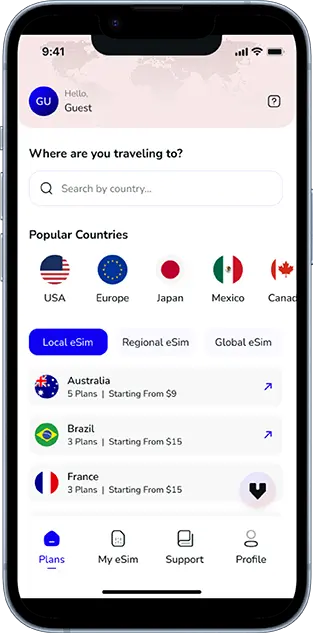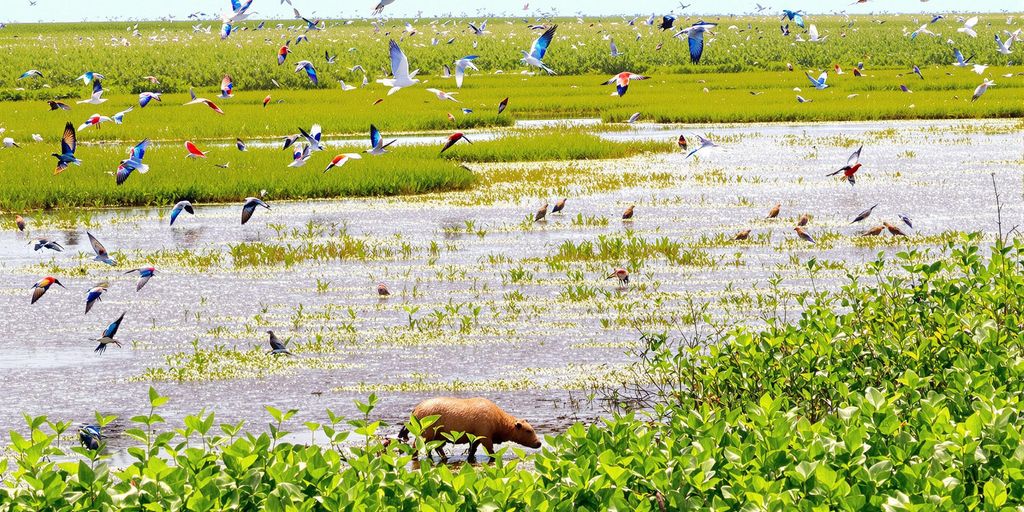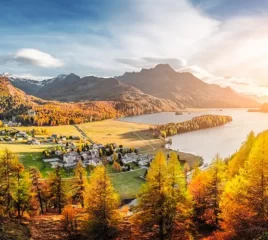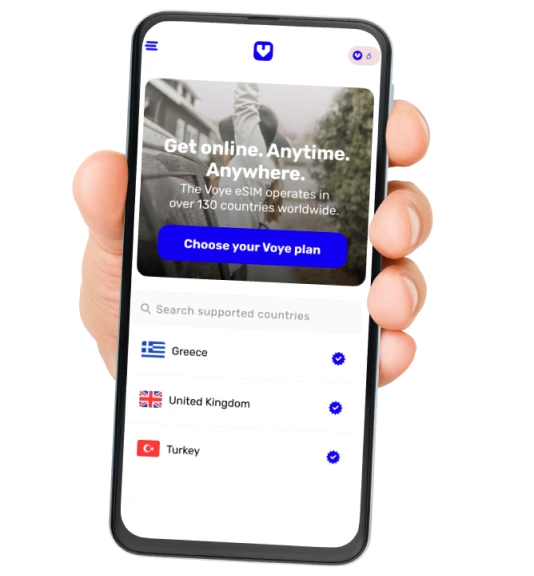Note that iPhone devices from Mainland China aren’t eSIM compatible. Also iPhone devices from Hong Kong and Macao aren’t compatible (except for iPhone 13 Mini, iPhone 12 Mini, iPhone SE 2020 and iPhone XS)
The Pantanal is one of the world’s most incredible natural wonders, offering a wildlife safari experience like no other. Stretching across Brazil, Bolivia, and Paraguay, this vast wetland is home to an extraordinary diversity of flora and fauna. Unlike the dense Amazon rainforest, the Pantanal’s open landscapes provide unparalleled opportunities to observe wildlife in its natural habitat. If you are an adventure seeker, a nature lover, or a wildlife photographer, a visit to the Pantanal is an unforgettable journey.
In this blog, we will explore the best time to visit the Pantanal, its diverse ecosystem, the majestic animals you can encounter, the best safari experiences, and practical travel tips to help you plan your trip.
Exploring the Unique Ecosystem of the Pantanal
Seasonal Floodplains and Their Role in Biodiversity
The Pantanal’s ecosystem is built around its seasonal floodplains, which flood during the rainy season and dry out in the dry months. These changes create a dynamic environment that supports a wide variety of life. When the rains come, the wetlands expand, providing a breeding ground for fish and a haven for migratory birds. During the dry season, the retreating waters concentrate wildlife around remaining water sources, making it easier to spot animals like capybaras, jaguars, and caimans. This seasonal rhythm ensures that the Pantanal remains one of the most biodiverse places on Earth.
Comparison with Other Wetlands Around the World
While the Pantanal is often compared to other famous wetlands like the Everglades in Florida or the Okavango Delta in Botswana, it stands out for its sheer size and biodiversity. Spanning over 150,000 square kilometers, it dwarfs most other wetlands. Unlike the Everglades, which have been heavily affected by human activity, the Pantanal remains relatively untouched. Its open landscapes and seasonal flooding make it an unparalleled destination for wildlife viewing, offering a unique experience that’s hard to find elsewhere.
The Pantanal as a UNESCO Biosphere Reserve
In recognition of its ecological importance, the Pantanal has been designated a UNESCO Biosphere Reserve. This status highlights its role in preserving biodiversity and supporting local communities. The designation also brings attention to the challenges the region faces, such as deforestation and agricultural expansion. Conservation efforts focus on balancing human activity with ecological preservation, ensuring that this vital ecosystem continues to thrive for future generations. The Pantanal is not just a natural wonder; it’s a global treasure that underscores the importance of protecting our planet’s unique habitats.
Wildlife Watching in the Pantanal
Spotting Jaguars in Their Natural Habitat
The Pantanal is one of the best places on Earth to see jaguars in the wild. These elusive big cats are often spotted along riverbanks, especially during the dry season from June to October. As water sources shrink, animals congregate, making it easier to observe the jaguar in action. Unlike their counterparts in other parts of the Americas, Pantanal jaguars are known for their larger size and unique behaviors. They’ve even been observed hunting caimans and forming small coalitions, a rare sight among typically solitary predators.
Observing Giant River Otters and Capybaras
Giant river otters, known for their playful yet territorial behavior, are a highlight of any Pantanal safari. These social creatures often travel in family groups, communicating with a variety of vocalizations. Alongside them, you’ll frequently encounter capybaras, the world’s largest rodents. These semi-aquatic animals are usually seen lounging near water or grazing in groups. Both species thrive in the Pantanal’s wetlands, creating a dynamic scene of interaction and activity.
The Role of Guided Tours in Wildlife Exploration
Guided tours are the key to unlocking the Pantanal’s incredible biodiversity. Local guides, with their deep knowledge of the area, significantly increase your chances of spotting rare wildlife. Tours are often conducted by boat, jeep, or even horseback, each offering a unique perspective on the wetlands. Night safaris are another popular option, providing opportunities to see nocturnal creatures like ocelots and crab-eating foxes. Guided excursions not only enhance the experience but also ensure that wildlife encounters are respectful and sustainable.
Global Coverage, Local Rates
Experience hassle-free connectivity wherever you go.
Birdwatching Paradise: Avian Wonders of the Pantanal
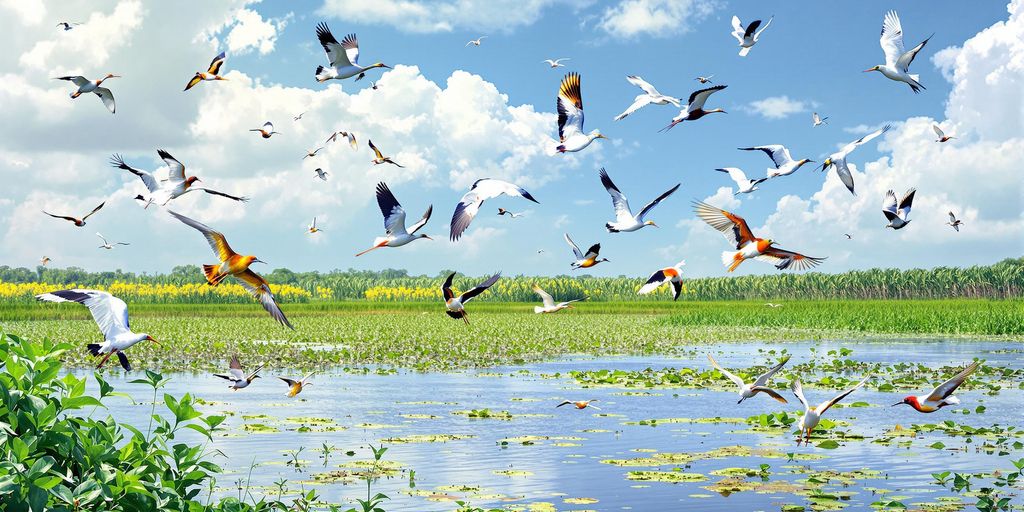
Hyacinth Macaws: The Largest Flying Parrots
The Pantanal is famous for its vibrant birdlife, and the hyacinth macaw is one of its most celebrated residents. Known as the largest flying parrot in the world, these brilliant blue birds are a sight to behold. They often perch on tree branches or forage for palm nuts, their primary food source. Seeing a group of these macaws in their natural habitat is a highlight for many visitors. Their striking color contrasts beautifully with the lush green landscape, making them a favorite subject for photographers and birdwatchers alike.
Migratory Birds and Their Seasonal Patterns
The Pantanal serves as a crucial stopover for migratory birds from across the Americas. Species like ospreys, wood storks, and flycatchers travel thousands of miles to rest and feed in this wetland. The region’s seasonal changes play a big role in attracting these birds. During the dry season, shrinking water sources concentrate fish and other prey, making it easier for migratory birds to hunt. Observing these seasonal visitors offers a fascinating glimpse into the interconnectedness of global ecosystems.
Iconic Birds Like the Jabiru Stork and Toucans
No trip to the Pantanal is complete without spotting the iconic jabiru stork. With its long legs and distinctive red neck, this bird is a symbol of the region. It’s often seen wading through shallow waters, searching for fish and amphibians. Toucans, with their brightly colored bills, add another layer of charm to the Pantanal’s avian diversity. These birds are not just beautiful but also vital to the ecosystem, helping to disperse seeds and maintain the health of the forest. Together, these species highlight the incredible biodiversity that makes the Pantanal a birdwatcher’s paradise.
Mammals of the Pantanal: A Closer Look
The Elusive Maned Wolf and Its Habitat
The maned wolf is one of the most fascinating yet rarely seen mammals in the Pantanal. Known for its long legs and striking reddish coat, this unique creature is not a true wolf but a species all its own. It primarily inhabits the drier regions of the Pantanal, often near the transition zones between the wetlands and the Cerrado, Brazil’s tropical savanna. These solitary animals are omnivores, with a diet that includes fruits like the lobeira, or “wolf apple,” as well as small mammals and birds. Spotting a maned wolf is a rare treat, as they are more active during twilight hours and tend to avoid human activity.
Capybaras and Their Role in the Ecosystem
Capybaras, the world’s largest rodents, are a common sight in the Pantanal. These social animals are often found near water, lounging in groups along riverbanks. They play a crucial role in the ecosystem by serving as a primary food source for predators like jaguars and caimans. Additionally, their grazing helps maintain the balance of aquatic vegetation. Capybaras are surprisingly agile swimmers, and their semi-aquatic nature allows them to escape predators by diving into water. Observing these gentle creatures in their natural habitat is a highlight for many visitors.
Unique Behaviors of Pantanal Jaguars
The jaguars of the Pantanal are unlike those found elsewhere in the Americas. These big cats are known for their size—they are among the largest jaguars in the world, thanks to the abundant prey available in the wetlands. Interestingly, Pantanal jaguars have developed unique hunting behaviors, such as preying on caimans and even capybaras. Unlike their counterparts in dense rainforests, these jaguars are more easily spotted due to the open landscapes of the Pantanal. Recent studies have also observed rare social behaviors, with some jaguars forming temporary coalitions, which is unusual for this typically solitary species. For wildlife enthusiasts, a jaguar sighting is often the pinnacle of a Pantanal safari.
The Pantanal’s Reptiles and Amphibians
Yacare Caimans: Guardians of the Wetlands
The Pantanal is home to one of the largest populations of yacare caimans in the world, with estimates reaching into the millions. These reptiles are a vital part of the ecosystem, acting as both predators and prey. During the dry season, they congregate around shrinking water sources, creating a spectacle of nature. While they may seem intimidating, yacare caimans are crucial for maintaining the balance of aquatic life, feeding on fish and smaller animals while also providing a food source for larger predators like jaguars.
The Yellow Anaconda and Other Snakes
Slithering through the wetlands, the yellow anaconda is one of the most iconic snakes of the Pantanal. Unlike its larger cousin, the green anaconda, the yellow anaconda is more commonly spotted in these wetlands. These snakes are non-venomous constrictors, preying on fish, birds, and small mammals. Besides the anaconda, the Pantanal is home to a variety of other snake species, including the venomous lancehead and coral snakes. Each plays a unique role in controlling populations of smaller animals and maintaining ecological balance.
Frogs and Toads in the Seasonal Floodplains
The Pantanal’s amphibians are perhaps the most vocal residents of the wetlands, especially during the rainy season. Frogs and toads thrive in the temporary pools created by seasonal flooding. Species like the giant toad and the tree frog are common sights. These amphibians are not just fascinating to observe; they are also indicators of the wetland’s health. Their presence often signals a thriving ecosystem, as they are highly sensitive to environmental changes and pollution.
Your Journey, Our eSIM
Stay online abroad with instant activation.
Best Times to Visit the Pantanal
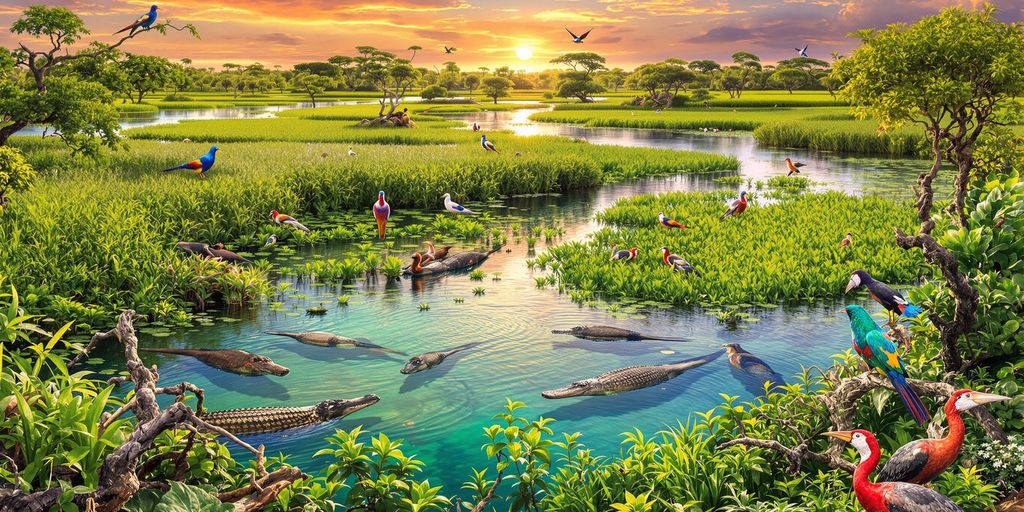
Dry Season Highlights: May to October
The dry season is hands-down the best time to explore the Pantanal. From May to October, the floodwaters recede, revealing a landscape teeming with wildlife. Animals like jaguars, capybaras, and giant river otters gather around the remaining water sources, making them easier to spot. October, in particular, can get pretty hot, but it’s also when wildlife sightings are at their peak. If you’re a bird lover, this is your golden window. You’ll find flocks of herons, egrets, and the iconic Jabiru stork clustered around shrinking waterholes. Plus, the vibrant Tabebuia trees are in full bloom, adding pops of color to the scenery.
Rainy Season and Its Impact on Wildlife
Come November, the rains start pouring, and the Pantanal transforms into a sprawling wetland. While it’s not the best time for spotting land animals, the rainy season has its own charm. The landscape turns lush and green, and the waterways come alive. You’ll see aquatic species like caimans and fish thriving in their element. Migratory birds also make their grand appearance during this time, adding a splash of activity to the skies. The downside? Travel can be tricky, with flooded roads and limited access to certain areas. But if you’re up for an adventure, the rainy season offers a unique perspective of the Pantanal.
Seasonal Changes in Vegetation and Scenery
The Pantanal’s scenery shifts dramatically between seasons, offering something new every time you visit. During the dry months, the landscape is more open, with golden grasses and exposed riverbanks. This makes it easier to spot wildlife. In contrast, the rainy season turns the area into a lush, water-filled paradise. Trees and plants thrive, creating a dense, green canopy. Whether you prefer the stark beauty of the dry season or the vibrant greenery of the wet months, the Pantanal never fails to impress.
Activities for Adventurers in the Pantanal
Horseback Safaris Across the Wetlands
Exploring the Pantanal on horseback is a must-do for anyone looking to connect with this vast landscape. The experience is both serene and adventurous, as you ride through open fields, shallow waters, and lush vegetation. Even if you’ve never been on a horse before, the well-trained mounts and experienced guides make it accessible. This method of exploration mirrors how Pantanal cowboys, or “pantaneiros,” have navigated the region for centuries. It’s an incredible way to access remote areas, often leading to unexpected wildlife encounters.
Boat and Canoe Excursions for Close Encounters
The waterways of the Pantanal are teeming with life, and there’s no better way to experience it than by boat or canoe. Gliding through the calm waters, you’ll have front-row seats to spot caimans sunbathing, capybaras grazing on the banks, and an array of bird species flying overhead. Canoeing offers a quieter, more intimate experience, while motorboats allow you to cover more ground. For an added thrill, some tours include piranha fishing, where you can try your luck catching these infamous fish and perhaps even enjoy them as part of a local meal.
Night Safaris to Spot Nocturnal Creatures
As the sun sets over the wetlands, a whole new world awakens. Night safaris in the Pantanal offer a unique opportunity to see nocturnal animals like ocelots, crab-eating foxes, and even the elusive jaguar. Guided by experts with spotlights, these tours take you into the heart of the wilderness under the cover of darkness. The sounds of the night—chirping frogs, rustling leaves, and distant animal calls—add to the sense of adventure. It’s an experience that’s as thrilling as it is unforgettable.
Photography in the Pantanal: Capturing Nature’s Beauty
Tips for Photographing Wildlife in Open Spaces
Photographing wildlife in the Pantanal can be an exhilarating yet challenging experience. Here are a few practical tips to make your shots stand out:
- Stay Patient: Animals in the wild don’t follow a schedule. Waiting quietly often leads to the most rewarding moments.
- Use the Right Gear: A telephoto lens is essential for capturing distant creatures like jaguars or birds without disturbing them.
- Focus on the Eyes: When photographing animals, sharp focus on their eyes brings life and emotion to your images.
Also, remember to respect the animals’ space. Getting too close can stress them out or even put you in danger.
Best Locations for Stunning Landscape Shots
The Pantanal is a dream for landscape photographers. Its vast wetlands, winding rivers, and golden sunsets create stunning backdrops. Some of the best spots include:
- Cuiabá River: Perfect for sunrise shots with mist rising over the water.
- Open Grasslands: Capture the expansive beauty of the plains, especially during the dry season when the horizon seems endless.
- Flooded Forests: During the rainy season, these areas create mirror-like reflections that are visually striking.
Experiment with different angles and perspectives to showcase the diversity of this unique ecosystem.
Using Natural Light to Enhance Your Photos
Natural light in the Pantanal is a photographer’s best friend. The soft, golden hours of sunrise and sunset are ideal for capturing warm, glowing images. Midday light can be harsh, but it works well for high-contrast shots of reptiles like caimans basking in the sun.
- Golden Hour: Use this time for warm, diffused lighting that flatters both wildlife and landscapes.
- Overcast Days: Clouds act as a natural diffuser, softening shadows and highlighting details.
- Night Photography: If you’re up for it, night safaris offer opportunities to capture nocturnal creatures under the stars.
With a little planning and creativity, the Pantanal’s natural beauty can translate into breathtaking photographs.
Travel Smart with eSIM
Enjoy uninterrupted data in the Pantanal eSIM.
Conservation Efforts in the Pantanal
Protecting Endangered Species Like the Giant Otter
The Pantanal is home to some of the most unique and vulnerable wildlife in the world, including the endangered giant otter. These charismatic creatures rely on clean waterways and abundant fish populations to thrive. Conservation programs have been working to monitor their habitats, reduce water pollution, and establish protected areas where they can live undisturbed. Researchers also collaborate with local communities to educate them about the importance of preserving these animals, creating a balance between human activity and wildlife survival.
The Role of Ecotourism in Conservation
Ecotourism has become a cornerstone of conservation in the Pantanal. By attracting visitors who are eager to experience its natural beauty, the region generates funds that can be reinvested into protecting its ecosystem. Many eco-lodges in the Pantanal operate with sustainability in mind—using renewable energy, minimizing waste, and offering low-impact activities like canoe trips and birdwatching tours. When tourists choose these options, they contribute directly to conservation efforts while enjoying an authentic experience of the wetlands. Supporting local guides and businesses also ensures that the economic benefits of tourism stay within the community, fostering a deeper connection to preserving the area.
Challenges Posed by Agriculture and Development
Despite its ecological significance, the Pantanal faces mounting threats from agriculture and urban development. Deforestation for cattle ranching and crop farming has led to habitat loss, while the construction of roads and dams disrupts the natural flow of water. These changes not only endanger wildlife but also affect the delicate balance of the wetland ecosystem. Conservationists are advocating for stricter regulations on land use and promoting sustainable farming practices to mitigate these impacts. Collaborative efforts between governments, NGOs, and local stakeholders are crucial in addressing these challenges and ensuring the Pantanal remains a haven for biodiversity.
Cultural Experiences in the Pantanal
Traditional Cattle Ranching and Its History
In the Pantanal, cattle ranching is more than just an economic activity—it’s a way of life. The region’s “fazendas,” or working ranches, offer visitors a glimpse into the traditions of rural Brazil. These ranches are steeped in history, dating back centuries when Portuguese settlers first introduced cattle to the area. Today, many of these ranches still operate using time-honored techniques, blending old-world charm with modern sustainability practices. Guests can participate in activities like horseback riding, cattle herding, and even learning local cowboy songs. Spending a day on a fazenda is like stepping back in time, offering a unique perspective on the cultural heritage of the Pantanal.
Local Cuisine and Culinary Delights
Food in the Pantanal is a reflection of its diverse cultural influences, combining indigenous, Portuguese, and African flavors. Visitors can savor dishes like “arroz carreteiro” (a savory rice dish with beef), “pacu assado” (grilled local fish), and “sopa paraguaia” (a cornbread-like dish). Meals often feature ingredients sourced directly from the wetlands, such as freshwater fish and tropical fruits. Many ranches and eco-lodges host cooking demonstrations, allowing guests to learn how to prepare these traditional dishes. Sampling the local cuisine is not just about eating; it’s about understanding the history and lifestyle of the region.
Interacting with Indigenous Communities
The Pantanal is home to several indigenous communities, each with its own unique traditions and way of life. Visitors have the opportunity to engage with these communities through guided tours and cultural exchanges. Activities might include learning about sustainable fishing and farming practices, participating in traditional dances, or observing the creation of intricate handicrafts. Some communities also host festivals that showcase their music, storytelling, and rituals. These interactions provide a deeper understanding of how indigenous peoples have adapted to life in the wetlands, preserving their culture while coexisting with nature.
Comparing the Northern and Southern Pantanal
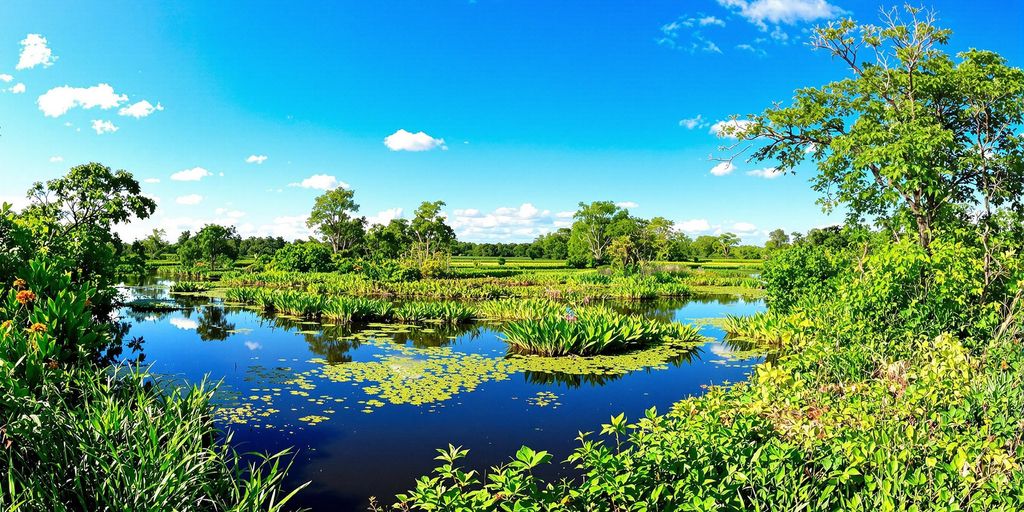
Wildlife Differences Between the Two Regions
The Pantanal is a vast wetland, but its northern and southern regions offer distinct wildlife experiences. In the north, jaguars are the undeniable stars. They roam the gallery forests and waterways, making this region a hotspot for big cat enthusiasts. On the other hand, the south is known for its open grasslands, where giant anteaters and maned wolves are more commonly seen. Birdwatchers will find treasures in both areas, but the specific species vary slightly, with the north offering more opportunities to spot waterbirds like herons and the south showcasing grassland birds.
Unique Landscapes and Habitats
The northern Pantanal is dominated by rivers, dense forests, and swampy areas. This makes it ideal for boat safaris and river-based activities. The southern region, however, features sprawling savannas and drier landscapes, perfect for horseback riding and open safari tours. Both regions experience seasonal flooding, but the extent and impact differ, shaping the habitats uniquely.
Travel Tips for Exploring Both Areas
- Transportation: Traveling between the north and south can be challenging due to the vast distances. Consider chartered flights for convenience, as driving can take over 10 hours.
- Best Time to Visit: The dry season (May to October) is ideal for wildlife spotting in both regions, but the north might offer better visibility during this period due to its waterways.
- Accommodation: Lodges in the north often focus on river access, while southern lodges highlight activities like horseback safaris and eco-farm stays. Choose based on your preferred activities.
Whether you explore the jaguar-filled waters of the north or the grassland habitats of the south, the Pantanal promises an unforgettable adventure. Each region brings its own charm, making it worth considering a visit to both if time allows.
Planning Your Pantanal Wildlife Safari
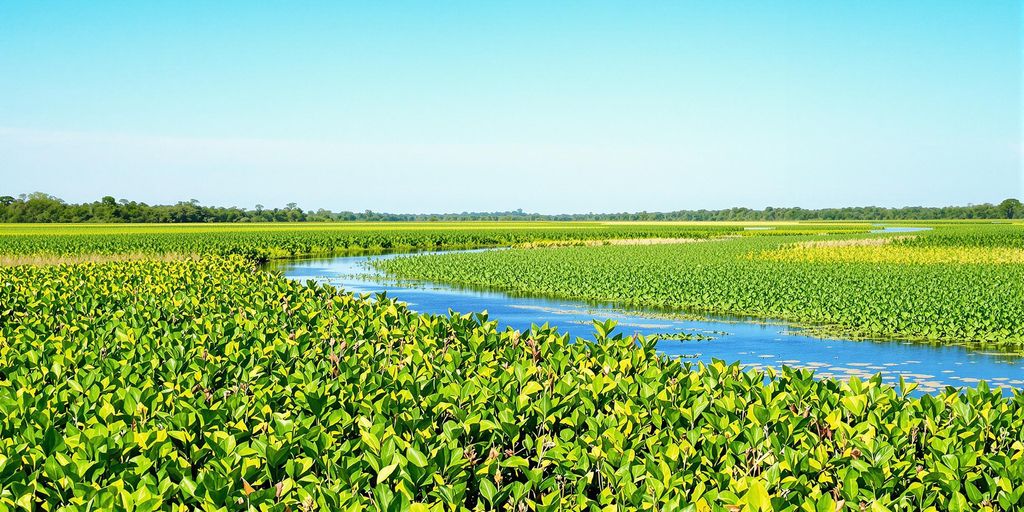
Choosing the Right Guided Tour
The Pantanal is massive, and picking the right tour can make or break your trip. Start by deciding what you want to see. Are you hoping to spot jaguars, or is birdwatching your main goal? Some tours focus on specific wildlife, while others cover a bit of everything. Look for operators who have experienced guides—local knowledge is key here. Also, check if the tour offers a mix of activities like boat rides, jeep safaris, or even walking tours. A good tour will take you to the best spots for wildlife, not just the most accessible ones.
Packing Essentials for a Wetland Adventure
Packing for the Pantanal isn’t like packing for a city break. Here’s what you’ll need:
- Lightweight, breathable clothing: It gets hot, but you’ll also want long sleeves and pants to protect against mosquitoes.
- Waterproof gear: Rain can hit unexpectedly, especially during the wet season.
- Binoculars and a camera: You’ll regret it if you don’t bring these for wildlife spotting.
- Insect repellent: The mosquitoes are no joke.
- Comfortable shoes: Whether you’re trekking or just walking around the lodge, good footwear is a must.
Health and Safety Tips for Visitors
The Pantanal is generally safe, but you’ll want to take some precautions. First, make sure your vaccinations are up to date, especially for yellow fever. Bring any medications you might need, as pharmacies are few and far between. Stay hydrated—it’s easy to get dehydrated in the heat. And always listen to your guide. They know the area and the animals, and their advice could save you from a dangerous encounter. Finally, don’t forget travel insurance. It’s better to have it and not need it than the other way around.
Wrapping Up Your Pantanal Adventure
The Pantanal is a place that stays with you long after you leave. Its sprawling wetlands, teeming with life, offer a rare chance to connect with nature in its rawest form. Whether it’s spotting a jaguar along the riverbank, watching a flock of vibrant macaws take flight, or simply soaking in the stillness of the marshlands, every moment feels like a gift. If you’re looking for a destination that combines adventure, wildlife, and a sense of wonder, the Pantanal is calling your name. Pack your bags, and let the wetlands show you their magic.
Seamless Mobile Data Everywhere
